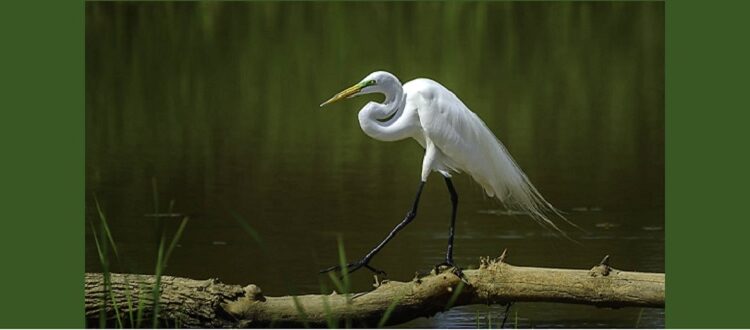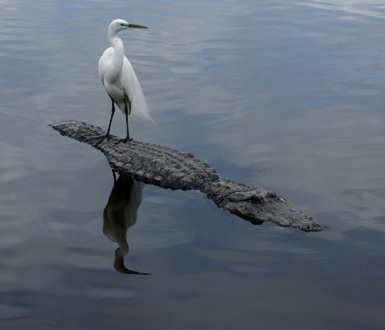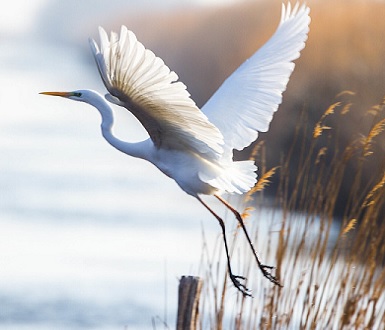CREATURE FEATURE – Great Egret
A Symbol for Conservation and Hope
GET TO KNOW
The Great Egret
Waterfowl, including the great egret, are the most glamorous residents of the watershed. The stately great egret, only a spring/summer visitor to southeast Michigan, is one of the largest birds to be seen in the Rouge watershed. It stands three feet tall and possesses a five-foot wingspan. This elegant bird has snow white feathers; and, during the spring breeding season, it is additionally adorned with a layer of long, soft, and wispy plumes. (See the wispy plumes on both the main image and the crocodile image.) Unfortunately, the egret’s beautiful breeding plumage almost brought about its demise as a species.
In days gone by, feathers adorned the hatbands of Golden Age business tycoons while elaborate feather plumes engulfed the hats of fashionable ladies. Feather trims were so popular, that bluebirds, woodpeckers, ducks, egrets, herons, and other lovely birds were hunted extensively. Great egrets, in particular, were hunted to the brink of extinction in order to support the demand for elaborate hat plumes.
In 1896 two cousins (both Boston socialites) objected to the feather trade. Together, Henrietta Hemmenway and Mina B. Hall, hosted a series of ladies’ teas in order to persuade friends and neighbors to boycott feathered hats. Those teas formed the early beginnings of the Audubon Society. The movement grew quickly, and in 1901, Congress passed The Audubon Model Law that specifically protected water birds from “plume” hunting for the hat trade.
Since that time, due to ongoing conservation and protection efforts, the population of great egrets has recovered. Today, great egrets are considered to be a stable species that resides across much of the world. In a time when new extinctions occur almost daily, the success story of the great egret is a reminder that we humans can both carelessly destroy – and consciously protect – the creatures of this world.
HABITAT AND LIFE CYCLE
The great egret is a wading bird that lives in quiet wetlands. The species lives year-round in the southern hemisphere, and only some individuals live a migratory life. In North America, migratory great egrets spend their winters in Mexico/Central America and travel north (as far as southern Canada) for breeding.
These birds are solitary hunters. They stand still and quiet, in shallow waters, while patiently watching for prey. Thus, they are often thought of as solitary creatures. However, great egrets actually roost in large colonies high in the trees. And while their hunting behavior may be quiet and solitary, their life in a colony is anything but quiet and solitary.
Colonies often include individuals of several species of wading birds. Within such colonies, nests are arranged in a hierarchy according to species size. The largest birds (the great blue herons) occupy the highest branches, egrets take the middle zone, and smallest waders get the lowest branches. Males, of all species, arrive early in the breeding season to claim individual territories and begin nest construction.
It seems that male egrets are highly territorial and aggressive, even to females. They start out defending large personal territories around a chosen nest site. However, out of necessity, they must continually reduce the size of their personal territories as new birds join the colony. Consequently, within a large colony, there may be a great many nests that, while close together, are vigorously and loudly defended.
Great egret males begin nest construction by building a large, sturdy platform of sticks. If available, prior year nests may be claimed and refurbished. Single males perform courtship rituals by raising their wispy breeding feathers, bowing, preening, and shaking sticks. Single females respond with similar behaviors. Breeding pairs work together to build large, cup shaped nest on the platform and to raise the young.
A female lays a small clutch (1 – 6) of light greenish/blue eggs that hatch in slightly less than 1 month. Both parents feed and aggressively defend hatchlings. Young egrets take their first flight at about six weeks of age but generally remain in the nest (for parental protection) for several additional weeks.
As large birds, great egrets are near the top of the watershed food chain, and there is little predation on adults. However, eggs and young hatchlings are at risk of predation from other birds (such as crows) and raccoons. When not hunted by humans, great egrets are known to live an average of fifteen years, and the oldest great egret on record reached twenty-two years.
TAKE ACTION
Today, great egrets are considered to have a stable population, but other species of waterfowl and migratory birds have not fared as well. Specifically, the whooping crane is believed to have a current total population of only 803 individuals and is at risk of extinction. Habitat loss, chemical contamination, and light pollution are currently the largest threats to our bird populations.
The EPA considers “non-source point” pollution (a.k.a. contaminated stormwater run-off) the greatest source of contamination to our waterways. FOTR strives to reduce local stormwater run-off, to protect the health and quality of the river’s water, to repair habitat areas, and to provide educational and volunteer opportunities. See “Our Work” page for more information on how we work to protect our watershed.
Main photo credit: Adult great egret (Ardea alba) with wispy breeding feathers – public domain






